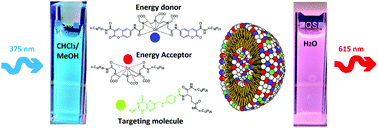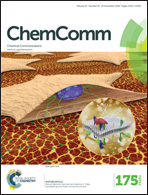Following the stability of amphiphilic nanoaggregates by using intermolecular energy transfer†
Abstract
An intermolecular energy transfer system is developed for studying the stability of nanoaggregate(s) (NAs) in complex solution and cell culture by one- and two-photon fluorescence microscopy and optical imaging. The system allows facile addition of one or more tumor targeting molecules, one of which is exemplified here. NAs functionalized with an MRI and optical probe, with and without folic acid, remain stable in fetal bovine serum for at least 4 hours. HeLa cell cultures showed a clear difference between NAs non-targeted and targeted to folate receptors, with both NAs appearing to be taken up by the cells through different mechanisms. An MRI relaxivity, r1, of 9 mM−1 s−1 at 310 K and 1.4 T was measured associated with the increased rotational correlation time of the NAs. These NAs may have application in the targeted drug delivery of hydrophobic drugs such as doxorubicin (DOX).


 Please wait while we load your content...
Please wait while we load your content...